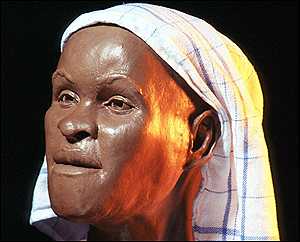
The Japan Times
September 22, 1999
REDISCOVERED (INDIGENOUS MOORS) IN BRAZILIAN MUSEUM
Skull alters theory on colonization of Americas
RIO DE JANEIRO (Reuters) Anthropologists unveiled the oldest known human fossil from the Americas on Monday, a woman’s skull with African features that could revolutionize theories about the continent’s early inhabitants.
The fossil — first discovered in Brazil in 1975 but only recently found to come from a woman who lived 11,500 years ago — shows there were human beings on the continent long before Asian immigration, said anthropologist Ricardo Ventura Santos.
“This is a piece that, in practice, is important toward understanding … the settlement of the Americas,” said Ventura Santos, of the National Museum and the prestigious Federal University of Rio de Janeiro (UFRJ).
“There’s a lot of curiosity about it, that’s why we’re showing it to the media today.”
Scientists dubbed the woman “Luiza,” Brazil’s answer to the famed “Lucy,” just over a year ago when new methods proved she was the earliest known American. Luiza’s namesake is a 3.2 million-year-old human ancestor found in Ethiopia and now on display in a Paris museum.
Scientists say Luiza was a nomad who wandered with about a dozen relatives in an area of what is now central Brazil, eating the natural vegetation or, on occasion, animal meat. She died at around age 20 in some sort of accident.
Before Luiza’s appearance, paleontologists had been working on the theory that the earliest Americans were the Asian ancestors of the Indians that European colonizers encountered when they arrived on the American continents 500 years ago.
These ancestors would have come from what we now know as Siberia and Mongolia, having crossed the Bering Strait between Asia and North America on a glacial bridge at the end of the last Ice Age.
About a year ago, archaeologist Walter Neves, one of the few specialists in human paleontology in Brazil, took an interest in the unusual shape of Luiza’s skull, which had been packed away for decades in the museum’s vast archives.
He believed the skull, which had been found in a 13-meter-deep cavern in the Brazilian state of Minas Gerais, showed Negroid features rather than the Mongoloid features typical of Brazil’s Indians.
“Its characteristics are very different in relation to the native population. Therefore, it has a very big importance, above all in explaining the settlement of the Americas and also for the history of humanity,” said Jose Henrique Vilhena, UFRJ’s director.
SCIENTISTS UNVEIL a reconstruction of Luiza’s head at the National History Museum in Rio de Janeiro on Monday. Luiza is considered to be Brazil’s oldest woman, based on remains found in the state of Minas Gerais that have been dated at 11,500 years old. AFP-JlJI PHOTO


Ivan Van Sertima has done a lot of research in this field that needs to be discussed more about the peopling of the Americas.
I went to Eagle Rock Mound in 2004 and on the plaque, it said (not word for word): “Tread here softly white man for in this very spot you lay your feet, many races of men have loved, hated, played, warred and died here.”
Blacks/Moors r indigenous worldwide. We were wiped out especially in Europe, Asia and parts of the Americas but still here with our mixed offsprings.
ivan sertima’s ideas have been refuted by most pre-colombian scholars.luzia isnt black the update is that she is the ancestor of the Botocudo(native american tribe in brazil) look it up.luzia isnt even the oldest skull look up EVA OF NAHARON 13,600 yrs old
Citations for your claims? Bare personal opinions are no go on Rasta Livewire.
Her thick lips and broad nose are distinctively traits of a black person. Also Luzia’s blackness has been proven as best it possibly could be are no one besides you disputes that reality .